Title: Concept of Demand and Supply in Economics
Category: Coursework
Sub Category: Micro Economics Assignment
Subject: Micro Economics
References: APA
1.0 Product Market Performance in Malaysia Market, a Microeconomic analysis:
1.1 Introduction:
This section aims to analyze the market performance of coffee. Findings from the study conducted shows there is significant increase in demand/supply for coffee in Malaysia. Statistics, (2018) shows that 670 thousand 60kg bags of coffee had been consumed in Malaysia in 2017 with the increasing trend during the last decade. According to the Sun, (2017; 11 May) Malaysia have a strong coffee drinking culture as an average Malaysian consumers 2.5 cups of coffee every day.
In this section author intends to analyze the product market performance of both normal and specialty coffee using micro economics concepts of demand, supply, market equilibrium, price discrimination and factors influencing demand and supply of coffee in Malaysia.
Using knowledge of micro economics learned in the class author has analyzed how Malaysian market place responds to various events which includes change in taste of consumers, income of consumers and other factors which effect prices and quantities of particular goods.
1.2 Demand Frontier:
Quantity demanded refers to the total number of coffee demanded by the buyer or total number of quantity of coffee buyers are willing to purchase at a particular period if all other things unchanged as per the rules of ceteris paribus.
Demand for normal and specialty coffee may significantly varies because of the concept of inferior and luxury good. Malaysia is a middle income country where there is low demand for specialty coffee as the price per cup is exponentially higher than the normal coffee available in the coffee shops in Malaysia. Quantity demanded for specialty coffee will be different due to its high price per cup.
| Price per Cup in RM | 8 | 4 | 2 |
| Quantity Demanded | 50000 | 100,000 | 150,000 |
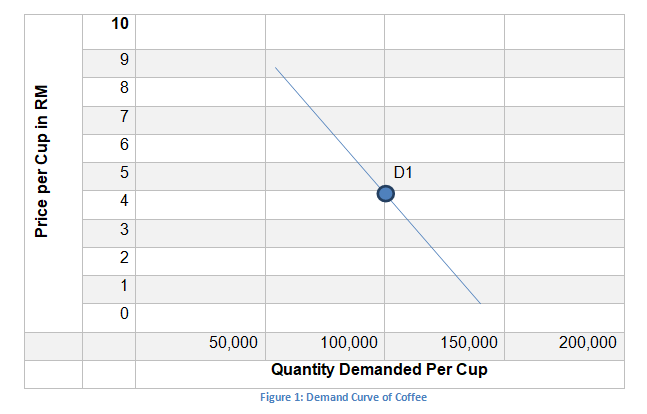

The demand curve shows the relationship between the price and quantity demanded of a good or service during a particular period. A change in price, with no change in any other variables that affect demand, results in a movement along the demand curve. For example to assume, 100,000 cups of normal coffee are sold each day in Kuala Lumpur at a price of RM 4, decrease in price from RM 4 to RM 3 will have significant effect on the demand. The below table shows the demand for coffee in Malaysia in terms of price and quantity if the price of coffee decreases. The demand curve will shift towards right side as showed in figure below.
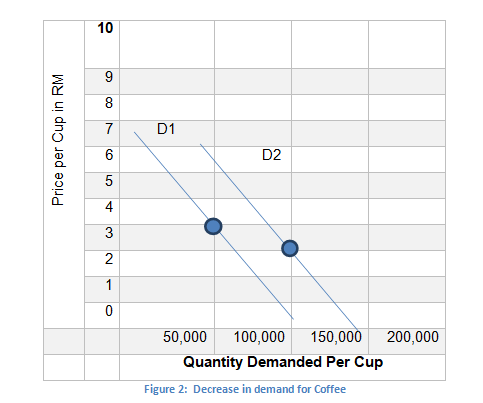
If price of normal coffee increase from RM 4 to RM 6 quantity of coffee demand will increase as a result the demand curve will shift towards left side as the price decrease the demand also decrease from 100,000 cups to 50,000 cups per day as showed in figure below.
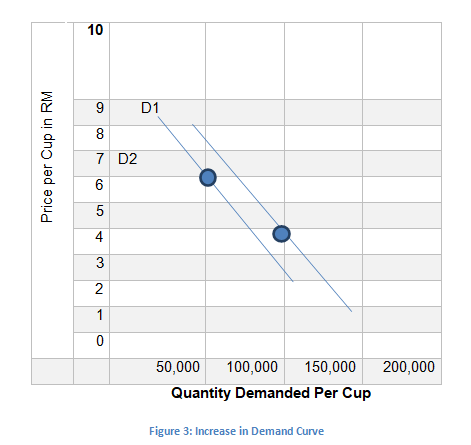
1.3 Supply frontier:
Quantity supplied refers to the quantity of coffee sellers are willing to offer for sale at a particular price where all the other things remains unchanged. The quantity supplied of a good or service is the quantity sellers are willing to sell at a particular price during a particular period, all other things unchanged. Ceteris paribus, the receipt of a higher price increases profits and induces sellers to increase the quantity they supply. The below figure shows the supply curve which shows that at Rm4 coffee sellers are willing to sell 100,000 cups per day.
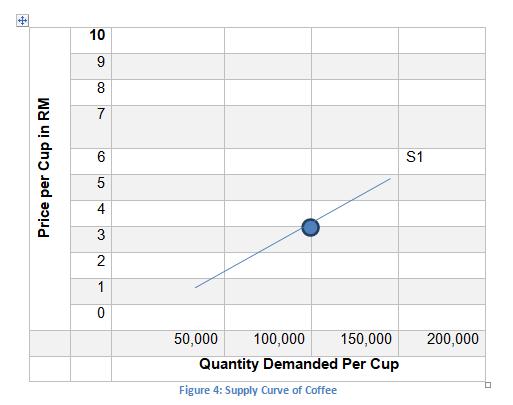
A higher price is likely to induce a seller to offer a greater quantity of a good or service. Production cost is another determinant, as well as the number of sellers are willing to offer coffee for sale. If price of coffee is RM 4 coffee chains are willing to sell 100,000 cups of coffee each day. However, if price of coffee increases from RM 4 to RM 6 coffee sellers and chains of both normal and specialty coffee are willing to supply 120,000 cups of coffee as the incentive for profit increases. The below figure shows, if price for coffee increases the supply curve shift upwards as coffee sellers will be willing to more cups of coffee.
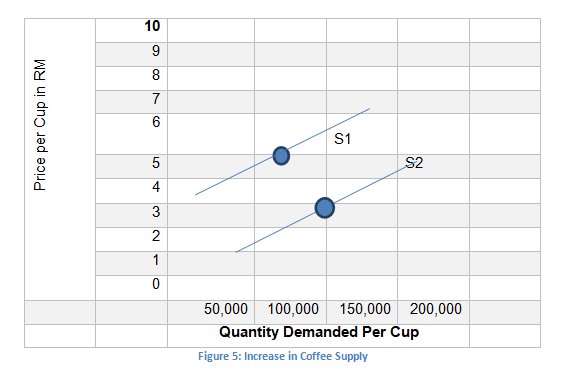
If the price of a normal coffee decreases from RM 4 to RM 3, coffee sellers and chains of both normal and specialty coffee are willing to supply less quantity of cups because the decrease in price will decrease the incentives for suppliers, as a result coffee sellers will be willing to sell only 75000 cups of coffee per day.
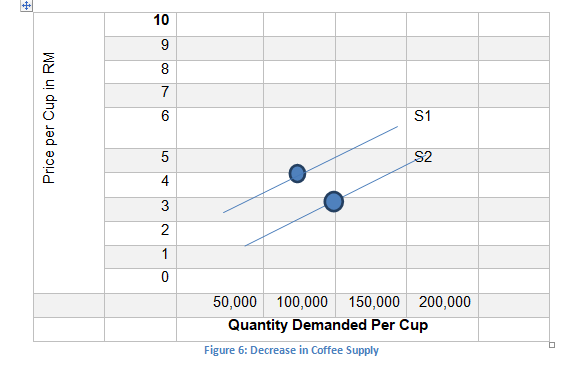
According to the above graphs it has been observed that theoretical law of Supply and Demand is also applicable in reality and practical life. According to Clark (1917) an increase in price does not necessarily mean an increase in supply and decrease in demand and vice versa. This would only be definitely true if all other factors that impact the supply and demand for coffee are held constant. However this is not the case in real life. According to Hilden brand (1983) there are various factors that impact the supply and demand for coffee in such a way that even if the price increase the supply falls or the demand increases which is a violation of the Laws.
[Get Competent Coursework Writing Help From Expert Coursework Writer and Boost Your Grades]
2.0 Factors that may Impact the Supply and Demand for Coffee in Malaysia:
2.1 Factors influencing demand for Coffee in Malaysia:
2.1.1 Change in Consumer Taste and Preference:
Change in consumer taste, habits, preferences and cultural custom significantly influence the demand for the goods. Many consumers in western countries tends to prefer decaffeinated coffee over normal coffee which can affect the demand for normal and specialty coffee. Overtime the tastes of the consumers change, people may now prefer another type of coffee or beverage. Some people may prefer specialty coffee instead of normal coffee due to better quality. It has observed that the specialty coffee consumption is much more than normal coffee consumption. The people who consumed normal coffee in the earlier years may have shifted to specialty coffee in the later years.
2.1.2 Population:
The world population is multiplying very quickly. The mortality rate too has fallen. As population increases, demand for goods too is bound to increase. Coffee is an essential part of almost every normal individual in Malaysia. A person usually takes 1 to 2 cups every day and as the population rises the demand for both coffees tend to rise. The demand for product will increase if there are more people in the market who want to purchase both normal and specialty coffee. Furthermore, the composition of population significantly affects the coffee demand. Society with high concentration of adults will have higher demand for coffee. On contrary, society with relatively more elderly persons has lower demand. Similarly, changes in the size of the population can affect the demand for coffee in Malaysia. Each of these changes in demand will be shown as a shift in the demand curve.
2.1.3 Related goods and Substitutes:
Demand for coffee can also be affected by the changes in price of related goods such as substitute and complements. A substitute is a good or service that can be used in place of another good or service. The lower price of substitutes decreases the demand for the other product however a higher price of substitute have reverse affect. Substitutes like tea and other beverages also change the demand for coffee. Substituting Normal Coffee for Specialty coffee will impact the demand for both coffees. If the price for tea decrease from RM 4 to RM 2, many consumers who are consuming coffee will shift to tea a low cost alternative of coffee. Similarly, if price for specialty coffee such as Starbucks increases, many Malaysians will prefer normal coffee over specialty coffee.
2.1.4 Income:
Income will have significant impact on demand of coffee, but the demand for coffee can significantly vary across normal coffee and specialty coffee because normal coffee is considered to be an inferior goods where coffee demand will falls when income rises as many consumers might look to purchase specialty coffee is a normal good where coffee demand will increase when income rises. Härdle et al. (1991) described that if income of the citizens’ increases the demand may also increases. People who could only afford one cup but wanted to consume more can now afford to do so.
2.2 Factors influencing Supply for Coffee in Malaysia:
2.2.1 Changes in Cost of Production:
Disruption of supply of coffee from the manufacturer and changes in production cost and related factors can cause an entire supply curve to shift right or left. This causes a higher or lower quantity to be supplied at a given price. The change supply of Coffee depends on the prices of all its essential ingredients. Change in prices of Coffee beans, milk etc. tends to impact the production and hence the supply of coffees. If coffee beans are not available in a particular season the production of coffee will automatically fall.
3.0 Market Equilibrium in Normal and Specialty Coffee Market:
Market equilibrium for a commodity occurs at the point where the demand for a good is equal to the supply of the good at the given price. Equilibrium price is the point at when quantity of a product demanded is equal the quantity of products supplied at the prevailing market price that point is known as market equilibrium. At this level there is no pressure to change the price Demand curve shows the price of a particular goods or services that buyers are willing to buy at a specific price whereas supply curve shows the quantities that sellers will offer for sale at each price during that same period. Intersection of demand and supply curves together shows the price at which buyers are willing to purchase and its equal to the quantity, the sellers are willing to offer for sale.
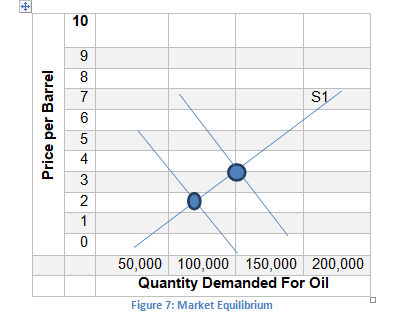
The above figure shows the equilibrium point where buyers are willing to purchase 10000 cups of coffee per day at the given price of RM 4 for normal coffee. Equilibrium point is where two lines intersect at a price of RM 4 per cup and the quantity demand is 100,000 cups. The market for coffee is in equilibrium. Unless the demand or supply curve shifts, there will be no tendency for price to change. The equilibrium price in any market is the price at which quantity demanded equals quantity supplied.
Unlike, normal coffee specialty coffee will have different market equilibrium. At the price of RM 8 per cup the demand for specialty coffee is 50,000 per day which is the market equilibrium point as showed in graph below.

Disruption of raw materials or changes in the Cost of Production can significantly affect product supply resulting in decline in supply curve for normal coffee. Supply curve shifts up and to the left because of the disruption of coffee supply from whole sellers. The price of coffee will increase and the quantity supplied will decrease because the demand for coffee remains relatively the same. People have coffee fixes and won’t want to give up their love of or dependence upon coffee.
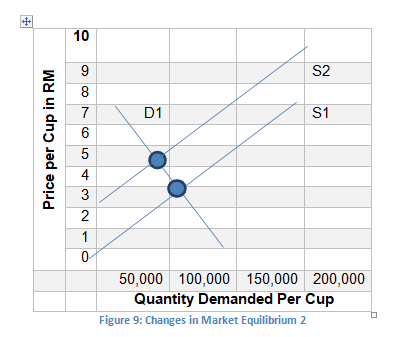
The above figure shows that disruption of supplies of coffee decreases the supply, as a result the price per cup increase from RM 4 to RM 5 and quantity supply decreases from 100000 cups per day to 75000 cups per day.
Increase in price of specialty coffee will significantly affect the demand as many consumers might shift to its low cost and affordable substitute which is normal coffee. Over time, demand will have dropped enough that the price of specialty coffee will return to its original dollar amount but at a lesser quantity supplied. This is how the market would usually respond without some form of compensatory strategy.
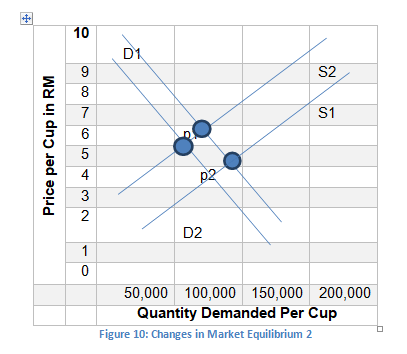
The above table shows that when the supply for coffee decrease the demand also decreases creating a new equilibrium point at a new price. However the decrease in demand normalizes the price of specialty coffee to normal.
4.0 Impact of Price Discrimination on the Coffee Market:
According to Laffont et al. (1998) the price discrimination is a pricing strategy, it can be defined as “practice of a firm selling a homogeneous commodity at the same time to different purchasers at different prices.” There are three types of Price Discrimination. (a) First price discrimination is also referred as perfect price discrimination, it occurs when the producer charges the maximum possible price for each unit consumed. Because prices vary among units, the firm captures all available consumer surplus for itself. (b) Second-degree price discrimination occurs when a firm charges a different price for different quantities consumed, such as quantity discounts on bulk purchases. (c) Third-degree price discrimination occurs when the producer charges a different price to different consumer groups. For example, a theater may divide movie ticket price into seniors, adults and children, each paying a different price when seeing the same movie. According to Armstrong, (2006) conditions required for price discrimination includes (a) firm must be price maker and operate in imperfect condition. For example if you are Starbucks in the coffee industry, the prices you set will usually hold. If you are an independent coffee shop, chances are, you are not a price setter and your customers will go elsewhere if you increase prices. In order to practice price discrimination, a company must have enough power in the industry or market to change prices, not respond to them., (b) firm must operate in separate markets and prevent resale, (c) difference in elasticity of demand amongst consumers. For example, normal coffee will target low income consumers like students whereas specialty coffee targets high income consumers and (d) firms must have low administrative cost to implement price discrimination. Microeconomic phenomenon was applied on both coffee markets to study its impact on the demand and supply for Coffee.
Impact of Price Discrimination on the Normal Coffee Market:
In this case the first degree price discrimination is used. The impact on Demand and Supply of coffee is observed if the firm charges the highest possible price. Price per cup of specialty coffee is RM 8 per cup resulting in demand of 50,000 cups per day in Malaysia. Coffee shops in Malaysia generate RM 400,000 revenue with inelastic demand. However, if the price of coffee is reduced to RM 6 the demand will increase from 50,000 cups to 75,000 cups per day closer to the price of normal coffee resulted in increase in demand to 75,000 cups producing revenue of RM 450,000 as showed in figure below
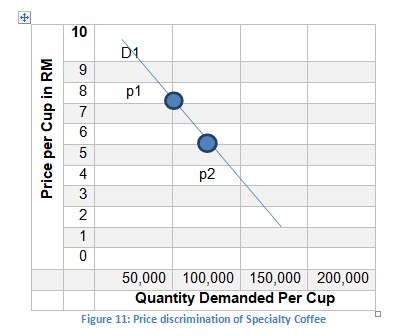
Varian (1989) describes that it is safe to assume that demand and supply will only increase at this price since the price is satisfactory and other factors tend to move both the supply and demand upward. Hence the values amount of coffee bags supplied and demanded annually will increase on hypothetical grounds.
5.0 Recommendations:
In the Normal Coffee Market following observations were made. Demand tends to rise as price fall but does not tend to fall very low even if the price rises, a reason for this may be is that Normal coffee is almost considered as a necessity for an average consumer. Supply tends to fall if price of the coffee falls and rise if price of the coffee rises. The demand for normal coffee is not highly influenced by price since even when the price dramatically decreased, the demand increased at a lower speed. However the supply of normal coffee is highly influenced by the price since when the price dramatically fell, the supply too decreased considerably.
On the basis of this Market Condition following recommendations can be made. Coffee shops should keep the price of normal coffee at an appropriate level, even if it is high because the demand elasticity of normal coffee is not very high; consumers will demand even if the price is high.
In the Specialty Market the following observation were made: Both Supply and Demand have high elasticity’s; as price increases the demand falls whereas the supply rises (Goldstein and Khan, 1978). However demand is more elastic than supply of specialty coffee. The price is constantly rising over the years due to the higher quality, standard taste and brand of the coffee. Market Equilibrium was not present, however the market was close to the equilibrium state when the price was at its lowest at RM 8 per cup. Based on the following observation the Market Condition for Specialty Coffee both the demand and Supply of the specialty coffee are sensitive to the change in Price. However the Demand is more elastic than the supply. An increase in price will result in the decrease in demand at a similar speed however a decrease in price will not necessarily result in a similar decrease in supply.
Conclusion:
The Coffee Market is a market with a lot of activity. Both Consumers and Producers are always present and are always involved in the buying and selling. We observed two types of coffee markets; Normal and specialty and used different microeconomic terms to analyze them. It is observed that in the Normal Coffee Market, the supply for coffee was more elastic than the demand. From this we conclude that normal coffee consumption is a basic part of a consumer’s life, not highly influenced by price. In the specialty coffee we observed that demand is more elastic than the supply. The high price of the coffee has resulted in a higher production of specialty coffee but a much lower demand.
[ For Acquiring Professional Essay Writing Help From Expert Writers. Just Send Us Request ‘ Write My Essay ‘]
REFERENCES:
ARMSTRONG, M. (2006). Recent Developments in the Economics of Price Discrimination. Advances in Economics and Econometrics, 97-141. Retrieved from http://else.econ.ucl.ac.uk/papers/uploaded/222.pdf
BLANCHARD, O. J. & QUAH, D. 1988. The dynamic effects of aggregate demand and supply disturbances. National Bureau of Economic Research Cambridge, Mass., USA.
CLARK, J. M. 1917. Business acceleration and the law of demand: a technical factor in economic cycles. Journal of political economy, 25, 217-235.
FISCHER, S. 1977. Long-term contracts, rational expectations, and the optimal money supply rule. Journal of political economy, 85, 191-205.
GALE, D. 1955. The law of supply and demand. Mathematica scandinavica, 155-169.
GOLDSTEIN, M. & KHAN, M. S. 1978. The supply and demand for exports: a simultaneous approach. The Review of Economics and Statistics, 275-286.
HÄRDLE, W., HILDENBRAND, W. & JERISON, M. 1991. Empirical evidence on the law of demand. Econometric: Journal of the Econometric Society, 1525-1549.
HILDENBRAND, W. 1983. On the” Law of Demand”. Econometric: Journal of the Econometric Society, 997-1019.
LAFFONT, J.-J., REY, P. & TIROLE, J. 1998. Network competition: II. Price discrimination. The RAND Journal of Economics, 38-56.
PHLIPS, L. 1983. The economics of price discrimination, Cambridge University Press.
ROBERTS, M. J. & SCHLENKER, W. 2013. Identifying supply and demand elasticities of agricultural commodities: Implications for the US ethanol mandate. American Economic Review, 103, 2265-95.
ULEN, T. S. 1989. 7 LAW AND ECONOMICS. Law and economics, 19, 201.
VARIAN, H. R. 1989. Price discrimination. Handbook of industrial organization, 1, 597-654.

